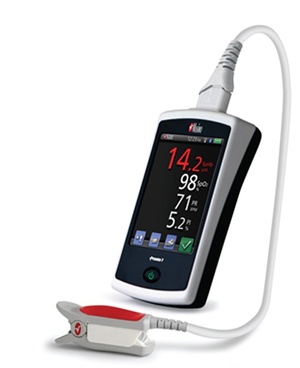US distribution deal for spectral blood sensor 03 Jul 2012 PSS World Medical to market Masimo's latest multi-wavelength spot-checker for hemoglobin,pulse rate and perfusion index.
 Pronto-7 oximeter
Pronto-7 oximeter
Masimo Corporation,the US manufacturer of medical sensors that acquired Spire's optoelectronics device foundry earlier this year,has agreed a major distribution deal for its latest multi-wavelength,non-invasive blood monitors.
PSS World Medical will distribute Masimo's"Pronto 7"handheld device across the US.The sensors in the device monitor light absorption at up to a dozen different wavelengths in the visible and near-infrared to yield fast and accurate measurement of a patient's total hemoglobin levels and other key health indicators.
The original technology behind the pulse oximeter received US Food&Drug Administration(FDA)clearance several years ago,with the latest generation of more compact Pronto-7 spot-checkers gaining approval late last year.
Its development has been recognized through several industry prizes,including the TechAmerica High-Tech Innovation Award and a gold medal in the Medical Design Excellence Awards,both in 2011.
Jon Coleman,Masimo's president of worldwide sales,marketing and clinical research,said in a company release:"With the full market release of our breakthrough non-invasive hemoglobin monitoring products,we can leverage the sales footprint and customer relationships of PSS's professional sales team to drive awareness of[the]technology."
PSS World Medical is a major force in the US medical market,turning over more than$1.5 billion in annual revenues.And although PSS is in the middle of a strategic restructuring,and now aims to focus on four key vertical markets within the medical sector,the new agreement promises to result in a growing demand for Masimo's light-based blood monitors.
Opto foundry deal
Masimo bought Spire Semiconductor's optoelectronics foundry in March this year,in a deal valued at$8.5?million,with a view to using the technology base for its own custom component requirements.The devices fabricated at the Hudson,New Hampshire,foundry feature in its hand-held spectral blood monitors,and acquiring the foundry gives Masimo much greater control over the supply of light emitters and detectors that it requires.
Although the principle behind the technology is simple,extracting clinically useful information is complex.For example,oxygenated hemoglobin shows a stronger absorption in the near-infrared region than in the red region of the spectrum–while a reduced total hemoglobin level is characterized by stronger absorption in the visible range than in the near-infrared.
This means that a simple two-wavelength oximeter is unable to make certain measurements,and explains why Masimo's monitors use so many wavelengths of light,combined with sophisticated signal extraction algorithms and adaptive filters,to yield useful information.
Measuring haemoglobin in this way provides physicians with a result in less than one minute,according to Masimo,with no requirement for needles,medical waste or waiting for laboratory analysis–with obvious benefits for patients where time is critical.
As well as total blood haemoglobin levels,the Pronto-7 tests for SpO2(blood oxygen saturation),pulse rate and perfusion index(an indicator of a patient's pulse strength).
Spokesmen for PSS say that the Masimo technology,which will feature future upgrades to support wireless transmission of patient data to electronic health records,is"transformational",and represents a significant breakthrough in patient management.
?The US Department of Defense Military Health System has selected Masimo's"Rad-57"Handheld Pulse CO-Oximeter as the military's standardized handheld pulse oximeter for use worldwide.
The department initially will use the Rad-57,which like the Pronto-7 is based on monitoring light absorption at multiple wavelengths,to measure oxygen saturation.
According to the company,the US Defense Department selected the Rad-57 after product evaluations at 13 different medical treatment facilities worldwide.The Rad-57 had already secured Air Worthiness Certification from the US Army and Safe-to-Fly Certification from the US Air Force.





